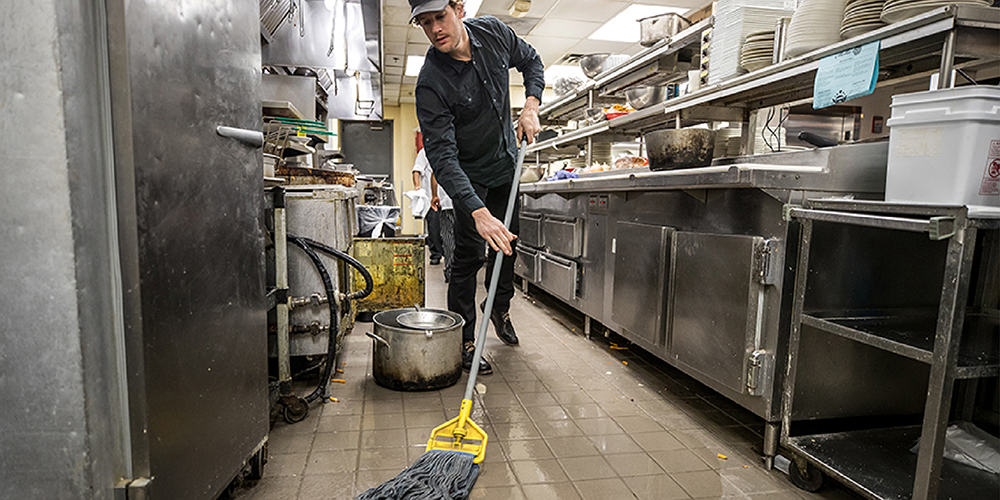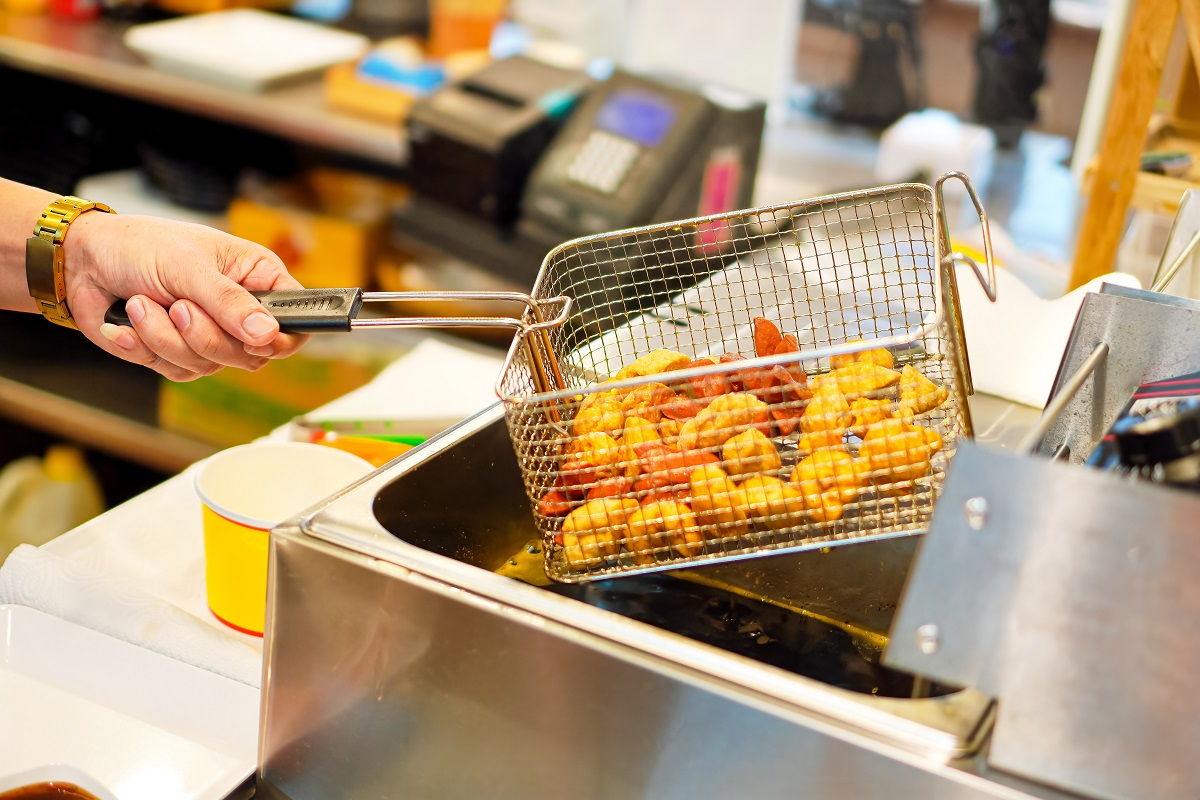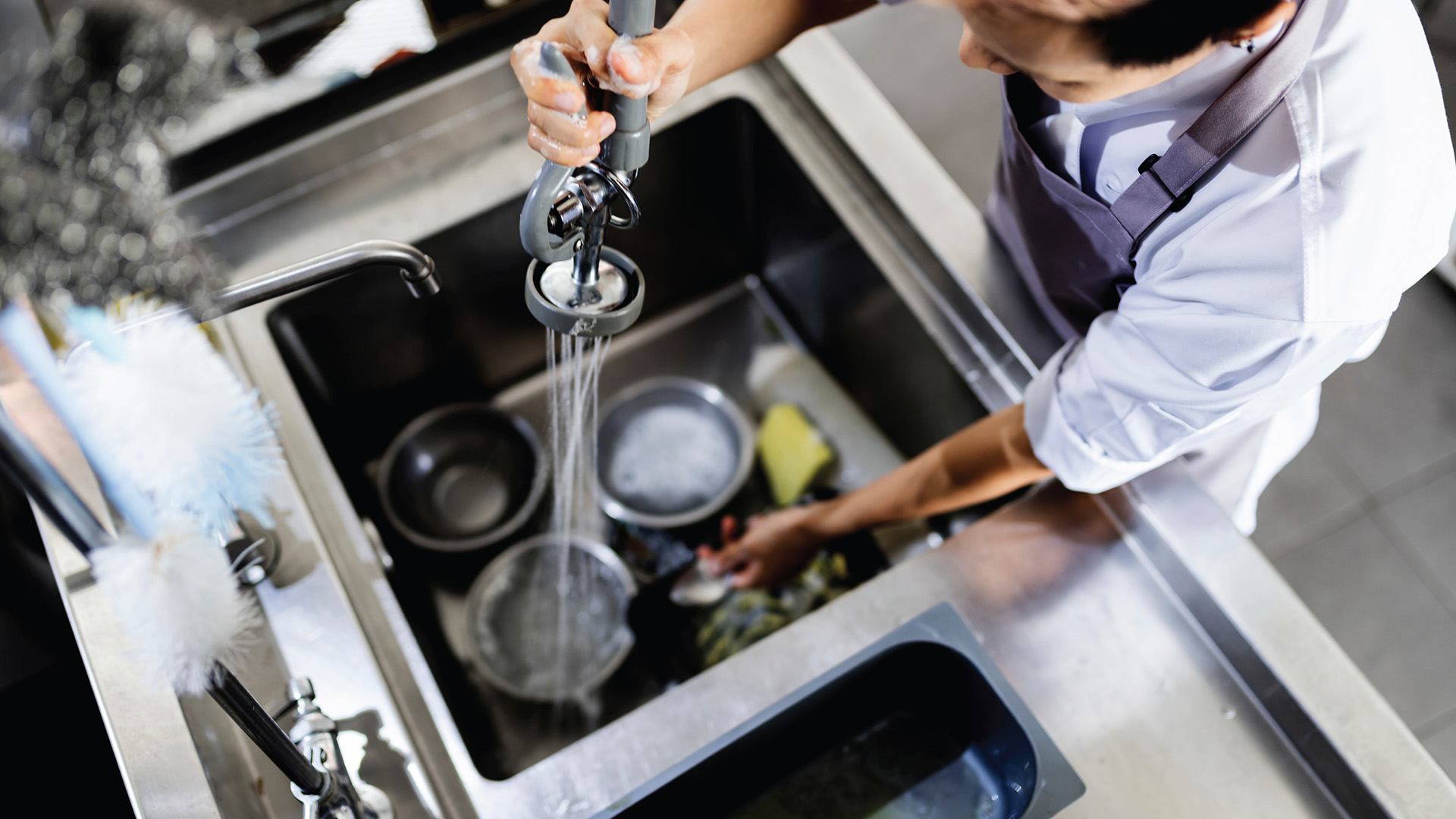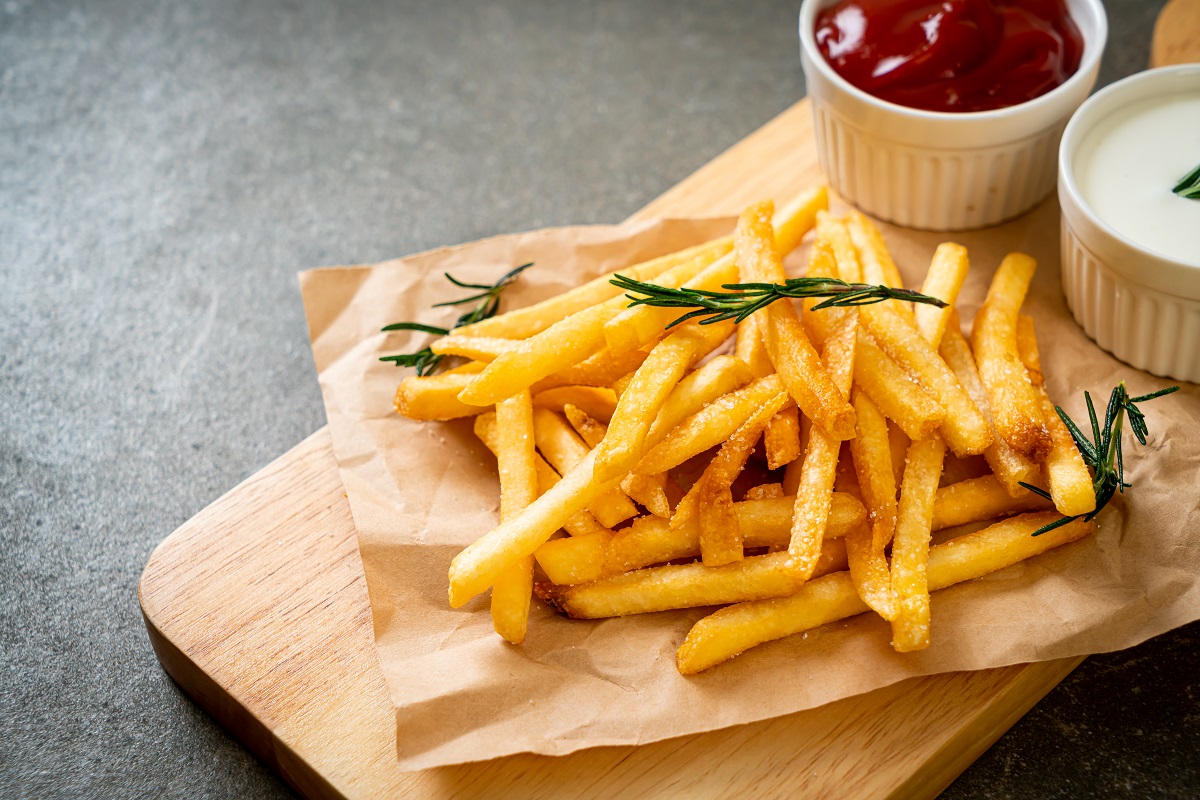Updated March 18, 2024
Cooking amazing food that satisfies your customers and builds your restaurant’s reputation is key to success in the industry. However, excellent meals take a lot of equipment to prepare, from deep fryers to stove tops and garnish stations—and all of it must be cleaned before you can start cooking again the next day.
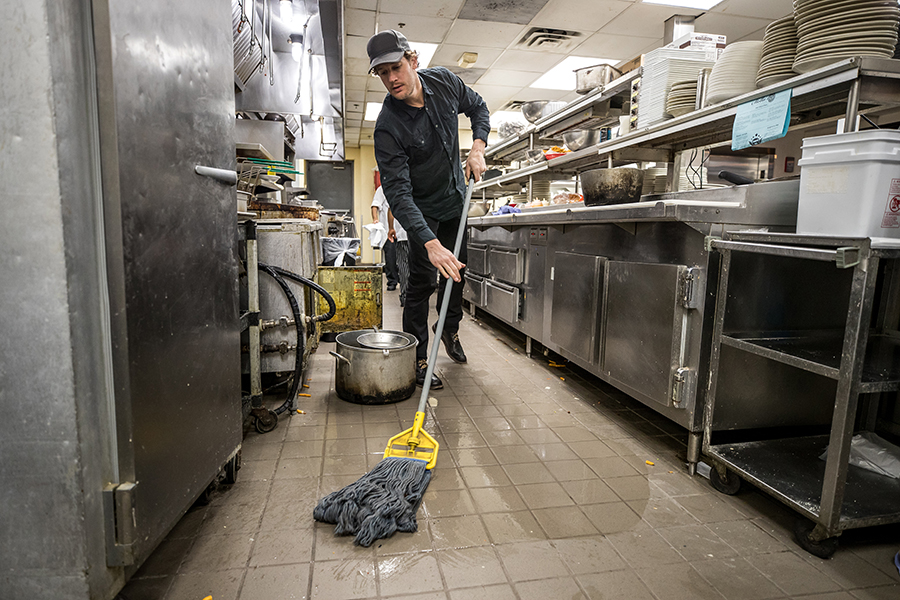
Tidying up is a chore at the best of times; at worst, it’s an arduous process that costs restaurant owners money but doesn’t generate any direct revenue for the business. So, to save time, effort, and cash, you should consider taking steps to simplify and expedite your restaurant cleaning procedures.
In this guide, we’ll share a succinct checklist of all the steps you should take when tidying up your back-of-house. Then, we’ll share some key tips—such as assigning roles and automating complex duties, that can increase efficiency when cleaning restaurant kitchens.
How to Clean a Restaurant On a Daily Basis
Envision your restaurant at its dirtiest, after non-stop service where every group is an eight-top and you’ve barely had a moment to wipe down the counters. It’s on these days that restaurant deep cleaning is at its most essential. Adopting a daily restaurant cleaning checklist for these busy days can ensure you keep your restaurant clean.
To make things simple amidst all that mess, we’ll lay out every spot you should spray, wipe, and scrub in a handy list. We’ll start from the top, as crumbs and dirt tend to fall downwards as you prep and polish high-up surfaces.
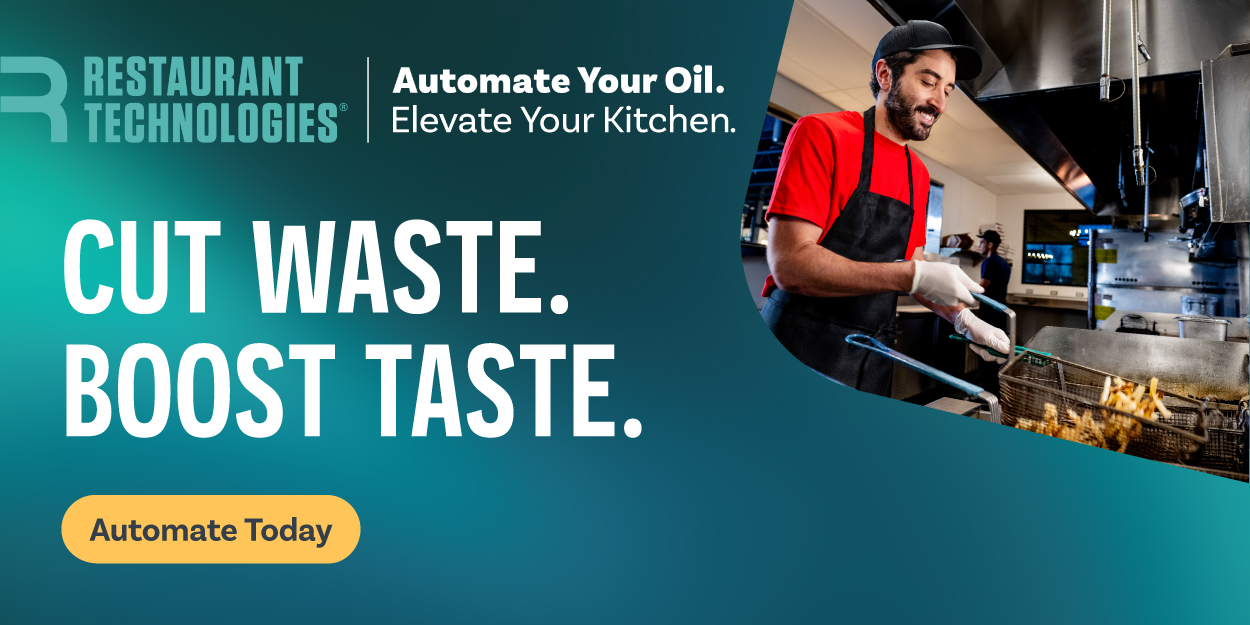
Here’s what you should do on a daily basis.
Mist Off Hood Vents and Controls
As steam rises and carries grease into the air, it coagulates and builds up on the surface, interior, and controls of your hood vent. Solidified fats can be stubborn and some cleaning professionals call for soap mixed with vinegar and isopropyl alcohol to remove them.1
Scrub the Walls Near the Prep Area
Moving downward from the hood, the walls are our next stop. Spray them down and wipe off any accumulated grease and grime—the longer you let it sit, the harder it will be to remove later.
Brush Off and Wipe Down the Stoves
Little bits of food and splatters of oil quickly build up and burn on stovetops. While you can’t keep every crumb in the pan, you can ensure your workstation is sparkling clean at the end of service.
Spray the hob down with a strong solvent and wipe away until you restore its original shine. If necessary, remove the burners and clean up any morsels that slip through the cracks. Otherwise, you can slide out the drip tray and scrub it to your heart’s content. Regular cleaning of a stove’s drip tray and grease trap is a must-have on a restaurant kitchen cleaning checklist. Provide staff with the proper cleaning supplies to efficiently clean stoves and complete this necessary but unpleasant cleaning task.
Deal with Dishes, Cutlery, and Kitchen Tools
If you have a commercial dishwasher capable of handling all of your plates and silverware, simply load it up and start the cycle. If you have to hand wash any pots, pans, dishes, or cutlery, take care of it before tackling the floors and counters; otherwise, incidental spray can make a mess of your otherwise pristine kitchen.
Scrub and Sanitize the Counters
Kitchen staff should be wiping down countertops multiple times per day, especially when bits of debris start to pile up or you prepare raw meat. Invest in cleaning rags and sanitizing wipes to ensure your counters meet food safety standards.
At the end of the day, however, you should pay them extra special attention. Spray all workstations down with a product specifically designed to sanitize restaurants and make sure their surface is sparkling clean and ready for the next day’s rush.
Filter the Fryer Oil
After crisping up fries, fish, falafel, and other favorites in your deep-fryer, you’re bound to have a dirty oil vat. Let the oil cool, then strain out any bits through some cheesecloth or a fine sieve to repurpose the oil for the next day’s service—just make sure it’s still usable before frying again. Explore how to reduce food waste in restaurants and implement new cost-saving and sustainable strategies to improve your business.
You can fry multiple batches of food in a vat of oil before it goes bad, but there’s no cut-and-dry number of times you can reuse it. Nevertheless, some signs indicate it’s gone off2:
- The color is dark and cloudy
- It’s giving off an abnormal odor
- There’s smoke or froth forming
- The viscosity is changing
Rather than constantly keeping an eye out for these subtle signs, however, there’s an easier way to check the status of your oil. Automating fryer oil filtration and monitoring can save you a serious headache during clean-up time.
By remotely monitoring key indicators of your oil’s health and usability, you can quickly decide if it’s perfectly seasoned or time to swap it out. Furthermore, automating your restaurant’s entire oil usage removes the need to physically empty, filter, and refill each vat while maximizing your oil’s lifespan and eliminating spillage. Consider an automated oil solution to make fryer clean-up as simple as closing the lid.
Regular oil filtration and cleaning also helps prevent burns in the kitchen by reducing the chances of a grease fire. Ensure your staff is properly trained in restaurant fire safety in case a fire does occur in your kitchen.
Put Everything Away
You’re almost at the finish line! If your dishes, cutlery, and kitchen tools are already clean and dry, put them back in their proper places so that they’re easily accessible at the start of the next shift. Otherwise, leave it to the openers to unload the clean dishwasher the next day.
Clean Up Cabinets, Mats, Floors, and Other Remaining Surfaces
Wipe grime downward off the front of cabinet doors. Then, shake down the floor mats before sweeping up and mopping. At the end of it all, you should have a floor that shines as brightly as a new piece of silverware.
Weekly Tasks for Cleaning Your Restaurant
While many tasks need to be repeated on a daily basis to ensure the cleanliness and sanitation of your commercial kitchen, some only need to be dealt with once a week. Pick a day when your evenings are slow (Mondays or Tuesdays may come to mind) and run through the following checklist3:
- Dispose of any expired food items taking up real estate in the fridge
- Wipe down the fridge’s interior shelves and walls
- Descale the sinks, faucets, and coffee makers
- Scrape out and wipe down the interior of your ovens
- Pour a commercial cleaner down the drains
Monthly Cleaning Considerations
Some areas of your kitchen may take longer to get dirty than others. Thus, there are some cleaning tasks that you only need to worry about on a monthly basis. So, when the 1st of a new month rolls around, be sure to3:
- Pull out large appliances and deep clean the spaces behind them
- Wash all of the walls, as well as the ceiling
- Empty out and clean up all the grease traps
- Clean and sanitize the interior of your ice machine and any beverage dispensers
Also, consider investing in a professional cleaning service to deep clean your dining area and kitchen once a month to be confident in your restaurant’s cleanliness.
While your monthly deep-clean might focus on behind-the-scenes gear, front-of-house tasks need just as much structure and attention.
Designate Front-of-House vs. Back-of-House Cleaning Tasks
Restaurant cleaning doesn’t stop at the kitchen doors. While your back-of-house team is scrubbing stovetops and draining fryer oil, your front-of-house team should be tackling customer-facing spaces. That includes wiping down tables, cleaning restrooms, and sanitizing door handles, menus, and POS systems.
Split responsibilities clearly between FOH and BOH to avoid gaps and overlap. Post a checklist at each station so every team member knows what falls under their shift’s to-do list. When everyone owns their section, the entire restaurant stays cleaner, and customers notice.
Tips for Smarter Cleaning Practices
It’s safe to say that most people don’t enjoy cleaning up and, frankly, it costs restaurant owners a lot of money. To expedite the process while still maintaining the high level of cleanliness necessary in a commercial kitchen, you can:
- Assign static roles – If you notice one employee is particularly effective at scrubbing down the counters while another excels at cleaning appliances, make those their permanent roles—the quality and efficiency will only improve with repeated practice.
- Organize cleaning products and tools – It’s impossible to sweep up when you can’t find the broom and there’s no way to sanitize the counters when the cleaning products are missing. Keep everything you need to tidy up in one easy-to-navigate area—preferably a dedicated supply closet if you have the space.
- Dispose of expired food as you go – There’s no need to wait until the end of the week to clean out the walk-in! If you notice something is out of date or going off, toss it right away, rather than leaving it for the Tuesday night crew. Making this a habit can ensure customers are never accidentally served expired food. Research other restaurant safety tips to ensure customer satisfaction remains high.
- Automate difficult tasks – The future is here! Spending hours scrubbing down hood vents and filtering fryer oil was once the bane of the back-of-house’s existence. Just be sure you know how often you filter cooking oil, and how to make fryer oil last longer. With automated cleaning and filtration systems, however, you can quickly accomplish these taxing tasks and return to preparing delicious food. Incorporating other restaurant kitchen efficiency tips into your employee training can lead to further organization and cleanliness.
- Post a Visible Cleaning Schedule – Between the dinner rush and late-night breakdowns, it’s easy for cleaning tasks to fall through the cracks. The fix? A printed, laminated cleaning schedule for your restaurant posted where your team can see it. Break down responsibilities by day, week, and month—and even by shift. Not only does this keep your kitchen running like a well-oiled machine, but it also helps hold staff accountable without constant reminders.
- Don’t Skip High-Touch Areas – Think beyond just surfaces and stovetops. High-touch areas like fridge handles, faucet levers, oven knobs, and light switches get a lot of love during service—but not always during clean-up. Make a habit of wiping these areas down at least once per shift. They’re easy to miss but just as easy to sanitize, especially with a dedicated cloth and disinfectant spray. It’s a small step that makes a big difference in preventing the spread of germs.
- Add a Shift-Change Clean-Up Routine – Closing clean-up can get overwhelming fast if every task is left until the end of the night. A smart way to stay on top of things is to incorporate a short checklist during shift changes
- Train and Cross-Train for Cleaning Consistency – Even the best cleaning checklist won’t help if your team doesn’t know how to use it. Part of building an efficient cleaning routine is making it a core part of your employee training. Walk new hires through your cleaning expectations just like you would with food safety, prep standards, or service steps. Show them how to properly operate cleaning equipment, how to safely handle chemicals, and where everything belongs at the end of a shift.
- Consider a Professional Deep Clean (Monthly or Quarterly) – While your team can handle daily and weekly duties, every restaurant benefits from a deep, professional clean once in a while. Consider scheduling a third-party service monthly or quarterly to hit every nook and cranny your team might miss, especially in the dining area.
Automate Your Cleaning Procedures with Restaurant Technologies
Two of your biggest cleaning tasks—scrubbing out your hood vent and filtering your deep fryer’s oil—can quickly become a thing of the past with Restaurant Technologies. Let’s start at the top: with your hood.
Our AutoMist Restaurant Hood Cleaner for Commercial Kitchens significantly reduces the time it takes to clean one of your kitchen’s greasiest and hardest-to-reach places. Rather than having to spray down and scrub your hood on a daily or weekly basis, you’ll simply have to empty the catch basin every once in a while—leading to hours of saved labor over the course of a year.
Additionally, our commercial cooking oil management solution takes the guesswork out of gauging your oil’s cleanliness. With our proprietary testing system, you’ll have instant insights into the quality of your oil delivered directly to your phone. Then, when it’s time to change the batch, simply push a button to drain out the old and bring in the new.
With Restaurant Technologies, cleaning your back-of-house can be easier than you ever imagined. Browse all our solutions to see what’s right for your space and begin streamlining your cleaning duties.
Sources:
- The Spruce. How to Remove Grease From Metal for Guaranteed Results. https://www.thespruce.com/how-to-remove-grease-with-vinegar-1387931
- Restaurant Business. Knowing when to change your frying oil. https://www.restaurantbusinessonline.com/advice-guy/knowing-when-change-your-frying-oil
- GrubHub. A 5-star restaurant kitchen cleaning checklist. https://get.grubhub.com/blog/restaurant-kitchen-cleaning-checklist/


